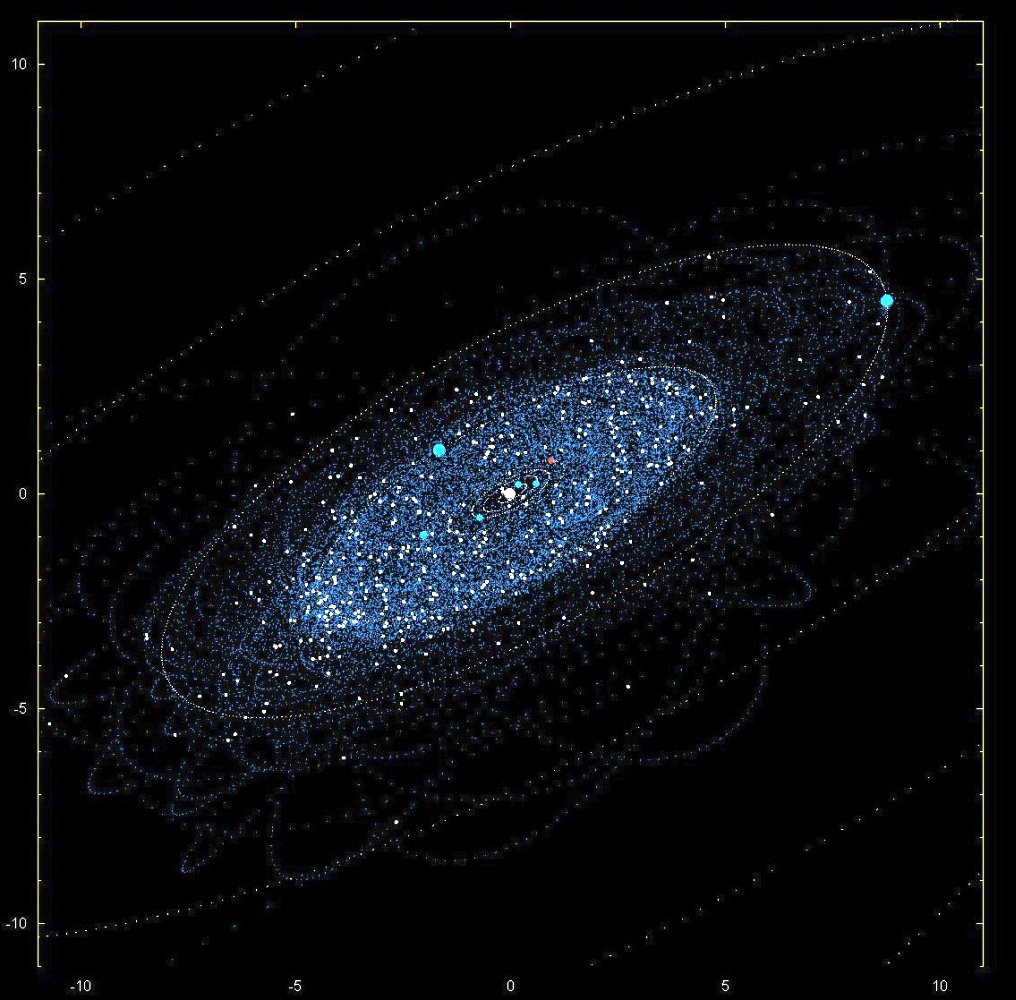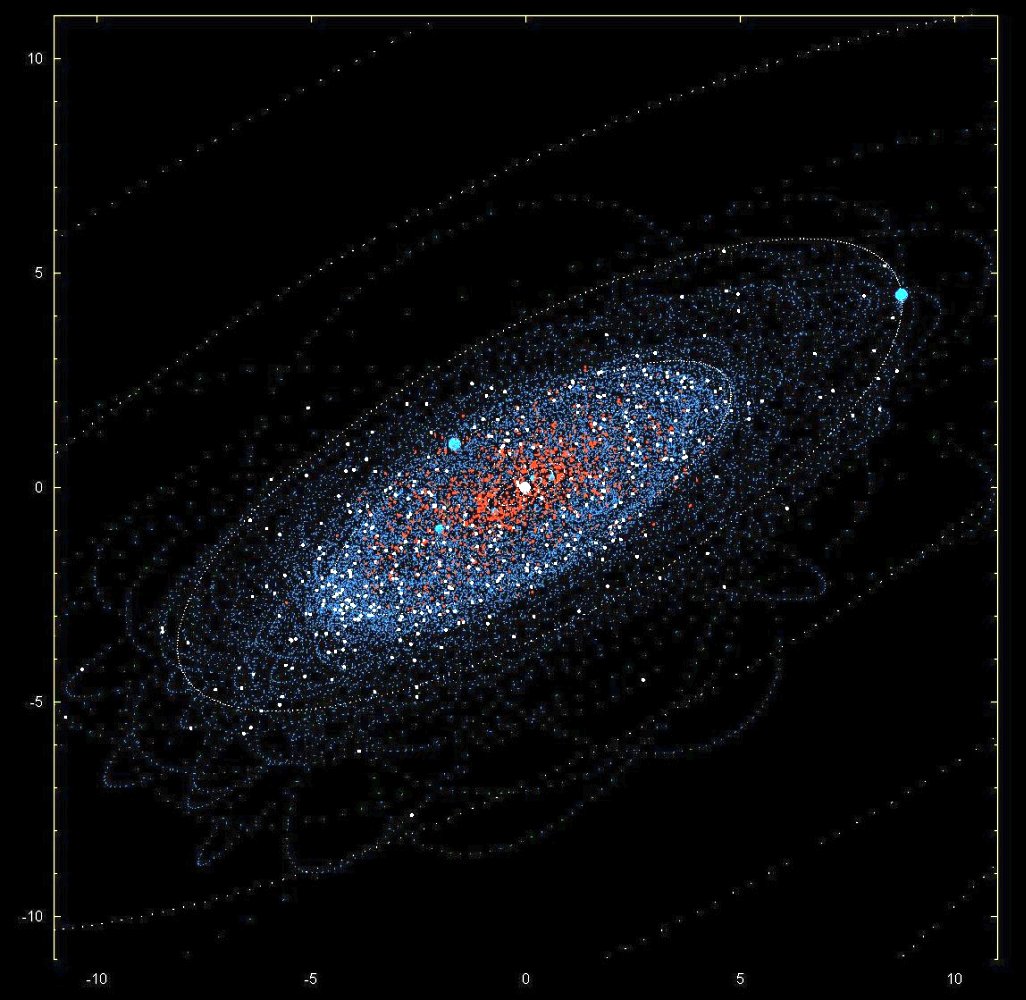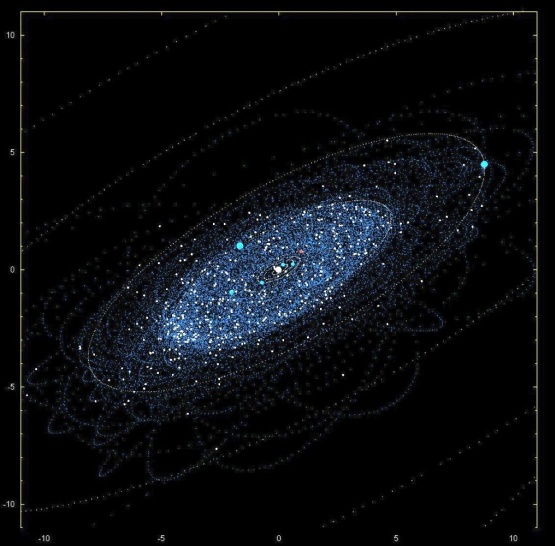near Earth water object candidates
as it was on 12 April 2011
A. Zuppero, Paul Sturrock, Costin Manda,
acknowledgment: Gabor Doka, key visualization principles
draft version 2011-05-19_1424
 |
|
Water Objects of the
neo solar system.
for 12 April 2011 4-th
Grade
Version
You are here: at the third blue
planet from the Sun.
The red stars are the thousand biggest near earth objects of the solar system. Forty percent are expected to have some kind of water. The white stars are comets that come by periodically: = water mud permafrost ice, dirt, hydrocarbons, rocks, sometimes just extremely black. Mars,
the
4th,
a
red
planet.
Ceres is the 5th, a rather small planet with low gravity and water ice recently observed on its surface. Jupiter is interesting because it is a Heavy Object. We can zoom around it and fling ourselves so fast we could zoom to Saturn, and even farther. |
| Professional Version | 4-th Grade version |
| "First views of the
near-earth-object
solar system through a digital algorithmic hyperspectral
telescope with
multidimensional filters." A.Zuppero, 2011-05-04, [myname]@neofuel.com |
We come to occupy the Solar System not as visitors, but as victors |
|
Only those things worth a $ Trillion Dollars delivered back here to Earth orbit are any good. Deliver water, rocket fuel and minerals to our gas station across from the moon. |
|
Any place we are
going must be at least as easy as getting to the Moon, or maybe the Moons of Mars, or Ceres, a little water planet just past Mars. Ceres could be a better alternate Earth, instead of Mars. You didn't know that because the Mars Nazi's kept shouting "Mars! Mars!" |
|
If we
are going to be dirt miners in
deep space,
we want
to be
like SuperMan.
They must have such low enough gravity that my wife could toss the car over the house. And if you jump up too fast, you could
jump
off,
and never get back. |
| During
the
last
dozen
years
about
7000
new
near
earth
objects
have
been
discovered
by "neologists". Less than about 300 neo's were known
during
1999 when we took a hiatus from working on this topic.
Digital camera
electronics enabled the discoveries. The computer takes
digital
pictures of the sky though a computer-pointed telescope
and picks out
those things that
move fast with respect to the background stars in the
sky. Those things
are then
tracked intensively. They were looking for objects that
might crash
into Earth. The low gravity enables affordable landing and launches, and launches of 1000 tons payloads by relatively small rockets. Instead, the neologists don't know it yet, they discovered about 1000 objects easier to get to than the moon. When calculating the economic value of the easiest approximately 100 of those would be worth, an interesting answer happened here. Water is everywhere. |
Water is Rocket fuel. It's like an oil field in space. Would supply gas stations out by the moon, and closer. Enough of everything to make giant space ships. Not now, of course. |
| The objects of the
image
are
either the
periodic comets (white stars)
--- water permafrost hydrocarbon ice objects , near earth objects (neo's, red stars) only those bright enough to suggest they are 1 km in size, or greater, and gravity potential well objects -- heavy planets highly useful for Oberth thrusting maneuvers,
which
enable
interplanet
trips.
The locations of all the objects are exact per calculaions using Minor Planet Center and Jet Propulsion Lab Ephemerides and patterned after examples by Professor Jeremy Tatum, UVIC, Canada, for 12 April 2011. The scale is in Earth-Sun distances, AU. In the picture seen from past Saturn, a picture as wide as 8 AU, you see exactly where the objects were on 12 April 2011, the day we started this neo solar system project. The view is a 4 AU plus/minus wide projection of the solar system, tipped 60 degrees from a normal to the ecliptic and then 30 degrees rotated left. This lest us see the entire accessible formation, the orbits of which extend to just past Jupiter. The "1 km" assures that of the 40% that do have water, those would have enough water such that if taken from them and delivered to Earth orbit, the total payloads would be worth at least more than USD $1 Trillion net to Earth orbit (earth-moon L5). "net" means with enough propellant left over to return to the neo and get more. A rather well known space geologist ( "neo-logist", Dr. Gene Shoemaker, deceased) asserted during the mid 1990's that up to 40 percent of the neo's have between 5% and 25% water, are crunch-able (= friable) clay-like objects, and most of the water can be "cooked" out of them by just heating them at self-cleaning oven temperatures (~ 300 C). Was he right? We can not believe until our remotely piloted vehicles go there and analyze them to find out. Recent data seems to suggest Gene heard it first and was telling all who had a reason to care. He told Anthony, then at DOE. Anthony would send his Avatars instead, because he likes it here. Each Avatar costs about $500 Million, delivered to neo. All the neo's and comets shown have low enough gravity that relatively small amounts of rocket reaction mass, ( " rocket fuel " ) would be expended in a launch of rocket fuel or other payloads. |
If you heat the neo's or comets water steam comes off. If you pump the water into a water balloon tank as big as a blimp, and then pump some water from the blimp into a nuclear reactor water boiler, and connect a rocket nozzle to the boiler, then your rockets could deliver rocket fuel (water) payloads that would weigh as much as 50 Space Shuttles.  Space Tanker for near zero gravity water objects of the neo Solar System |
(solsys_neos_pcomets)
solar system from past pluto of 1200 largest near earth objects
(red) and Jupiter family comets (white)
....
 |
|
Water Objects of the
neo solar system.
for 12 April 2011 Just the big neo's, with 11 AU window. Saturn is the upper right blue planet. Jupiter is the next closer one in. Then Ceres is in the middle of it. Mercury, Venus, Earth and Mars can be seen with difficulty as blue or red dots. |
....
 |
|
Water Objects of the
neo solar system.
for 12 April 2011 Notice the donut. It's comet dust. It seems to be corralled inside Jupiter's orbit and seems to end just inside Mars orbit. 4-th Grade
This is comet dust. Comets are water things. We live right at the edge of where the water things are. The Blue Fog is our Water Donut. There just have to be some comets in there because of all that comet dust. Professional
The periodic comet orbits are plotted as points with equal time between orbit point dots. Doing it this way, deliberately not connecting the dots, results in being able to "see" the chance of finding a water-ice permafrost object in any given region. The fog density is the approximate probability. Credit Dr. Mark Sykes Director, Planetary Science Institute, who suggested we plot it this way during the mid 1990's. Notice the "donut" starting at Jupiter's orbit and ending somewhere between Earth and Mars orbit. The first observation of this was made by Thomas Larson of the Idaho National Laboratory of the US Department of Energy, mid 1990's. |
....
(solsys_pcomets_orbitdust)
solar system from sun to Jupiter showing periodic comets and
their orbit debris tubes
 |
||||
|
Water Objects of the
neo solar system.
for 12 April 2011 The water donut stars
include
the
periodic comets and their orbits.
We live at the edge of the donut hole in the center. (Saturn is about +4 vertical, +8 horizontal)
|
....
 |
|
Water Objects of the
neo solar system.
Professional:for 12 April 2011 The orange
stars close to the Sun
and scary close to Earth and its orbit, are the largest 1000 near earth objects. Some are crushable chunks that give off steam when you roast them. The white stars are the comets that repeatedly come back. The blue white dust are what you find along a comet's orbit. The same as above now filtering in the 1 km or greater sized near earth objects. The red stars are the largest ~ 1000 neo's. |
....
 |
|||||
|
Comet dust of the
neo solar system.
for 12 April 2011
A
close
up
of
the
comet
orbits,
"comet
dust",
featuring
Ceres, the
blue "planet" dot at -1 vertical, -2 horizontal.
|
....
 |
|
Water Objects of the
neo solar system.
for 12 April 2011 a view of the neo solar system tipped almost edge on, from past Pluto, and Algorithmic filtering shows only the repeating comets and their orbits. blue-white-dots
...
repeating
comets
white fog ... comet orbits and dust The red object is Uranus, and the red one above it is smog laden Saturn, as references. |
....
 |
| Water
Objects of the
neo solar system. for 12 April 2011 Close up of comets and comet dust density |
....
 |
| Water
Objects of the
neo solar system. for 12 April 2011 Close up of just neo's, no comets. About a third of neo's are water objects of some mineral kind. Shown here is what we would see if we could see deep deep infrared at night, and digitally filter to select just neo's. |
....
 |
||
|
water
candidate near earth objects for 12 April
2011, enhanced. You live here,
at approximately -0.6 vertical, -0.6 horizontal.
|
....
 |
|
Water
Objects
of
the
neo
Solar
System
for 12 April 2011 In a different hyperspectral mapping than before, and now looking at the solar system from 45 degrees away from looking down at it; blue white: the repeating comets and their orbits white stars: near earth objects white spheres: planets Mercury, Venus, Earth, Mars, Jupiter largest orbit: Jupiter's Sun: black dot in the center. We don't yet know why there appear to be concentrations and gaps along Jupiter's orbit. --------------- 4th Grade: The sky on the night side of Earth ought to be full of water objects. But most of those looking can not see the cool dim glow of heat. They are humanoids, a relatively blind species. It's fun to see how we live in a swarm of things that could make us rich, that could be:
rocket
fuel
gas
stations
in
space
or could:
smash
into
Earth
and
end
it
all.
|
....
 |
| neo
space. for 12 April 2011 near earth object space. Close up of the water-objects candidates in the space near earth. A
fraction of
the red and white
stars
would be worth each at least $ 1 Trillion delivered to a gas station near the moon, we estimated. We can not charge customers very much, or they won't buy it. Economics and the market prevented us from charging customers more than about $100 per kilogram ( $ 50 per pound ) in our estimates, which is about 50 times less than current price. Water is rocket reaction mass (propellant) for steam rockets Water is rocket fuel ore.
For
powerful
cryogenic
and
nuclear
heated
rockets,
Liquid Hydrogen, Liquid Oxygen. |
This is just scratch paper.
We are changing it all the time.
It is also the first time anyone I know of has seen the
solar system of near earth objects
this way, from this angle,
through "digitally algorithmic hyperspectral eyes"
that filter in favor of gas stations in space.
It is just a draft, our scratch paper.
I also put it here because it was exciting.
Expect colleagues and friends to see it.
comments to: patent @ neofuel .com
.. Anthony
2011-04.28_1354, 2011-04-29_0901, 2011-05.03_1200, 2011-05-03_2039,
2011-05-04_0033, 2011-05-05_1429 2011_05_06_2357, 2011-05-10_1348
2011-05-11_1350, 2011-05-12_1026, 2011-05-13_0053 2011-05-19_1424
END
Teleprompter
The Missing Piece
that would enable us to occupy the solar system
2011-05-13_2241
/A Zuppero/
Anthony Zuppero
The digitally algorithmic
hyperspectral images
of the
water object candidate micro galaxy we are inside of
just simply jolted me.
When I first saw them
it was like waking up
into a new universe where we just found
the missing physics piece
to enable us to occupy the solar system.
We were missing
"the reaction mass"
needed to
conserve momentum
when accelerating through a total vacuum."
That is why we failed to go to space
and become a space faring nation.
We were trying to violate the law of
conservation of momentum.
It is a law of physics.
The missing piece.
With this one puzzle piece,
reaction mass,
we can travel the solar system.
Without this puzzle piece,
reaction mass,
we could not get on and off the moon.
Everybody knew it.
By now, after 50 years going to space,
we knew.
NASA and the USA and the world
were missing a piece that
the laws of physics demanded be there.
There was no reaction mass in the vacuum,
in space.
Therefore,
we can not go anywhere.
We are stuck here
with the terrorists and tax collectors,
with no way off.
That was my universe before 12 April 2011.
of the
water object candidate micro galaxy we are inside of
just simply jolted me.
When I first saw them
it was like waking up
into a new universe where we just found
the missing physics piece
to enable us to occupy the solar system.
We were missing
"the reaction mass"
needed to
conserve momentum
when accelerating through a total vacuum."
That is why we failed to go to space
and become a space faring nation.
We were trying to violate the law of
conservation of momentum.
It is a law of physics.
The missing piece.
With this one puzzle piece,
reaction mass,
we can travel the solar system.
Without this puzzle piece,
reaction mass,
we could not get on and off the moon.
Everybody knew it.
By now, after 50 years going to space,
we knew.
NASA and the USA and the world
were missing a piece that
the laws of physics demanded be there.
There was no reaction mass in the vacuum,
in space.
Therefore,
we can not go anywhere.
We are stuck here
with the terrorists and tax collectors,
with no way off.
That was my universe before 12 April 2011.
Suddenly,
like spashed in the face
by a bucket of fresh mountain rushing snow melt water
to wake you up,
you have the reaction mass to make it go.
like spashed in the face
by a bucket of fresh mountain rushing snow melt water
to wake you up,
you have the reaction mass to make it go.
The missing piece:
massive
discovery
of
reaction mass
Can you say
"super
califragilistic expialidocous" ?
(
Julie
Andrews, "Mary Poppins" )
Can you say
" digitally algorithmic hyperspectral imager " ?
" digitally algorithmic hyperspectral imager " ?
Water is the missing reaction mass.
Even the rocks in space
can hold water.
---


